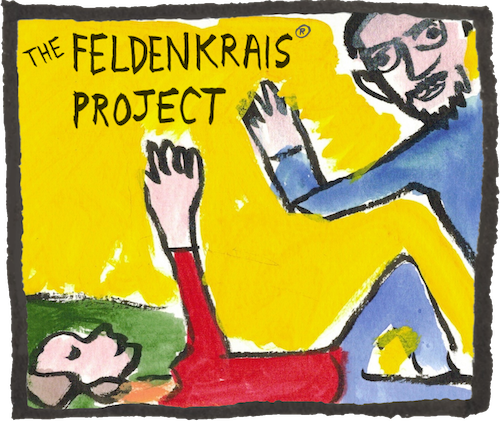Mostly side-lying, framed by standing and walking explorations. Using your sternum as a reference point, free your shoulders, hips, chest, and back for better posture and upright movement. Experience how different organizations of your torso affect your ability to move with freedom and confidence. Ends with a 2-minute talk from the after class discussion.
Back-lying, one or both knees bent, tilting the knees and letting their weight twist, turn, and lengthen the body. Transferring weight. Broadening and clarifying the function and ease of the pelvis, hip joints, and lumbar. Learning to bend and straighten the legs with the freedom of a baby. Integrating this learning through the whole self, including the chest, shoulders, head, and eyes.
Back-lying, knees bent, integrating bending of the ankles through the joints of the legs and into the pelvis and lower back, blending into a classic Feldenkrais lesson which draws the head, elbows, and knees toward each other in different combinations. Improve the folding and unfolding of the body through refining coordination of the flexor muscles, building awareness of the use of the ground (foundation), and lengthening the extensors.
Mostly back-lying, knees bent. The “tripod of the foot” lesson, great for improving feet, knees, hips, and more. Learn better awareness and control of the bones and muscles that create the fundamental ground contact structure of the body, and relate it to movements of the ankle, knee (especially the head of the fibula), hip, back, and beyond.
Lying on the back and front, and various kneeling and standing positions. Exploring and improving the use and awareness of the buttocks in relationship to the pelvis, legs, feet, belly, and spine. Once Feldenkrais fans are ready for this lesson it's a profoundly important one for better posture, walking, and running. See the Comfort & Configuration tab.
Back-lying, mostly one knee bent, one foot standing. Develop an action of lifting your hip forward in a grounded and distributed way as you learn to draw clear support from the earth up and through you. Great for stability, strength, and confidence in walking, and all upright movement. Framed by experiments in standing and walking.
Side-lying, integrating movements of the arms, shoulders, head, neck, spine, and hips. Learning to sense and hinge bodyweight in relation to the ground, and between the knees and feet. Great for adding grace and ease to how we twist, turn, and walk.
Back-lying, knees bent. A unique take on the classic Feldenkrais pelvic clock lesson. Learn how the interaction of the feet with the ground relates to the pelvis moving in all directions. Includes movements designed to integrate the spine, head, and eyes, all toward grounding and organizing the whole self for better walking and an easier upright life.
Various positions, about half back-lying. Experiments with the breath mechanism, learning how it relates to the head, spine, and pelvis, and integrates into the length of the heels for standing. Uses paradoxical breathing and "see-saw" breath games.
Back-lying, often knees bent. Some modified side-lying and brief front-lying. We can’t beat gravity, so let’s get organized to oppose it effortlessly with bones instead of muscles. Pushing and pulling movements from the feet, moving you up and down your mat, are throughly explored, as the horizontal floor substitutes for the plumb line of gravity.




Dear Nick
I do like your Felden-lessons. The audio is good, that is how you get the lessons in classes. I also subscribe to Alfons on uTube, he is in Austria, I think. His classes are also good. I watch the lessons first then do the lesson. Thank you very much for allowing us out there to participate. Enjoy your coffee, Kolla
I just love the new website! I love that it makes it so easy to find the lessons. This was a terrific idea!
Thank you! Fun fact: this is the first comment left on the new site. Thanks for joining the discussion!
Just did the first lesson on the site Nick.
Thoroughly enjoyed it.
Gave a lesson last night that really encouraged shoulder awareness so derived much more pleasure as a result.
Great recording and website.
Will be joining.
In appreciation.
Phil Smith.
Australian practitioner.??
Thanks so much! Glad to hear you’re using and valuing the Project!
Thank you Nick. This website is excellent. I’ll be joining.
Silvia Raabe
Hi Nick, i like your ATMs as inspiring tools for my work, i really dived into them, enriching them with my own way of teaching, I appreciate your way of giving lessons, the clarity into it. Thanks very much for this, Silvia
Glad to hear it! Thanks, and please share them!
I love your instruction, Nick. It’s very helpful for me. I have chronic pain and chronic fatigue, so I do wish you had some shorter lessons. I feel like I do on overload after 40 minutes or so, but I also want to get the full effect of the lesson. Do you recommend breaking it into segments for different days? Or do you offer some lessons that are shorter? Thank you!
Yes to breaking longer lessons into segments. You can read about that on my FAQ page.
And yes, we have lots of shorter lessons now! Check out Getting Oriented. And Patrons can find a section of shorter lessons in Straight from Class (everyone can click through to see the names and descriptions). All our short lessons are between about 25 and 40 minutes long.
Do you have any lessons to be done while actually walking rather than in preparation for or in relation to walking?
Not at this time, but that’s a nice idea for the future! Meanwhile, to help connect our lessons directly to your walking experience, I recommend taking a walk at your own relaxed speed (pace not set by another person or walking a dog) shortly after any of the lessons in this series. You can also play games with speed and stride, alternating experiments like that with simply walking in a way that’s natural to the moment. Natural surfaces are great when available. Finally, check out my blog post which may be helpful: Reflections and Lessons: We Evolved for Easy Walking.
Hi Nick thanks so much for this lesson. I managed most of it and imagined some of the remaining parts. I wasn’t quite clear on the last part when we walk around. My buttocks were more in my awareness but I found I was clenching them as I was walking. Should I be doi g this. Thanks onec again for a very useful lesson in moving through life.
Hi Pauline! You left this comment a collection page with eight lessons, but by context I think maybe you are responding to doing The Buttocks lesson? And yes, well-functioning buttocks will clench a little bit alternately, one-at-a-time, as we walk.
Thanks Nick. That clarifies things for me. Very much appreciated.
Hi Nick I thank you once again for these amazingly helpful lessons. Ive done your navigational pelvis a few times. When I’m walking I find my torso is sitting more comfortably on my hips and it’s a bit easier to keep my head looking straight ahead. But when standing I’ve noticed my pelvis will suddenly tip upwards making my back bend forward. I try to relax my knees but this still happens. Just wondering if you can clarify what I may need to change. I’ve been doing the lessons small and very slow. I appreciate any insights you may have. Thanks once again. Warm regards Pauline
Hard to say from a distance. Do you mean the top of your pelvis tips forward when standing, and that leaves you feeling less supported by your legs and back? If so, I suspect you may find it helpful to dive back into this collection’s buttocks, breathing, and anti-gravity lessons. In addition there are a few Patron lessons about lengthening through the heels that may be useful for organizing that skeletal standing line of feet, legs, pelvis, back.
And one of my favorite tips to remember about standing? It’s meant to be dynamic, flowing. Standing “still” is an image we fall into that’s contrary to our top heavy, two little feet design. Even if you don’t look like you’re fidgeting or shifting your weight, ideally in standing we can still feel like we’re moving, breathing, shifting subtly like the upside down pendulum that we are, continually lengthening our crown skyward, suspended and floating in gravity through our bones.
Hi Nick. Thank you for your detailed reply. What happens when standing is my pelvis kind of curls like a c shape from the bottom. My legs feel alot pressure to point of stiffness. It makes my body bend forward from about the middle of the spine and I have coreect my posture by standing straighter. It does happen when walking. I understand it is hard to understand from a distance. Hope I’ve explained it a little better. Warm regards Pauline Donohoe
Thanks for the detail. It’s very hard to describe dimensions of movement like this, but I believe my recommendations yesterday are still good. It may also be useful to look for a couple local or online 1:1 Feldenkrais lessons (not a service I offer, sorry to say) to help clarify things.
Thanks Nick. I’ll do that. Thanks once again for your support and making Feldenkrais accessible to many people from all walks of life. Warm regards Pauline Donohoe